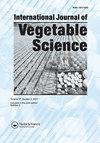Characterization of begomoviruses associated with emerging mosaic disease of ivy gourd (Coccinia grandis L.) in Tamil Nadu, India
Q2 Agricultural and Biological Sciences
引用次数: 0
Abstract
A systematic field survey was conducted in ivy gourd fields of Tamil Nadu during the year 2019-2021. The infected plants manifesting prominent chlorosis, mosaic, puckering, and yellow mosaic symptoms on leaves were tested through polymerase chain reaction (PCR) assay for the infection of begomoviruses. Amplicons of PCR from 5 samples were sequenced. 4 samples were infected with tomato leaf curl New Delhi virus (ToLCNDV) and one with Coccinia mosaic Tamil Nadu virus (CoMoTNV). The nucleotide sequences from isolates IGT-1 (OR041745) and IGP-1 (OR041746) have an identity of 96-98% with ToLCNDV isolate infecting chrysanthemum (MG758145) from Karnataka. Another isolate IGD-1 (OR041747) had 99.3% identity with tomato infecting ToLCNDV isolate (MW538662) from Raipur and isolate IGE-1 (OR041748) had 98.4% highest identity with the previously reported ToLCNDV isolates of India infecting bitter gourd. The IGS-1 (OR028863) isolate 98.9% identity at the nucleotide level with previously reported CoMoTNV (KY860899) infecting ivy gourd from Tamil Nadu. Phylogenetic analysis revealed that ToLCNDV isolates infecting ivy gourd were grouped under three different clusters reported previously reported from different parts of the globe. The present investigation reports the emergence of begomoviruses (ToLCNDV and CoMoTNV) on ivy gourd growing in different parts of Tamil Nadu.与印度泰米尔纳德邦常青藤葫芦(Coccinia grandis L.)出现的花叶病相关的begomovirus的特征
2019-2021年期间,在泰米尔纳德邦的常春藤葫芦田进行了系统的实地调查。采用聚合酶链式反应(PCR)检测了侵染begomovirus的植株叶片出现明显的黄化、花叶、皱缩和黄色花叶症状。对5份样品的PCR扩增子进行测序。4份样品感染了番茄卷曲新德里病毒(ToLCNDV), 1份样品感染了花叶泰米尔纳德邦球菌病毒(CoMoTNV)。分离物IGT-1 (OR041745)和IGP-1 (OR041746)的核苷酸序列与感染Karnataka菊花(MG758145)的ToLCNDV分离物同源性为96% ~ 98%。另一分离物IGD-1 (OR041747)与来自赖pur的番茄感染ToLCNDV分离物(MW538662)的同源性为99.3%,分离物IGE-1 (OR041748)与先前报道的印度感染苦瓜的ToLCNDV分离物的同源性最高为98.4%。IGS-1 (OR028863)与先前报道的感染泰米尔纳德邦常春藤葫芦的CoMoTNV (KY860899)在核苷酸水平上的一致性为98.9%。系统发育分析显示,感染常青藤葫芦的ToLCNDV分离株可分为全球不同地区报道的三个不同的聚类。本调查报告了在泰米尔纳德邦不同地区生长的常春藤葫芦上出现的begomovirus (ToLCNDV和CoMoTNV)。
本文章由计算机程序翻译,如有差异,请以英文原文为准。
求助全文
约1分钟内获得全文
求助全文
来源期刊

International Journal of Vegetable Science
Agricultural and Biological Sciences-Plant Science
CiteScore
3.10
自引率
0.00%
发文量
30
期刊介绍:
The International Journal of Vegetable Science features innovative articles on all aspects of vegetable production, including growth regulation, pest management, sustainable production, harvesting, handling, storage, shipping, and final consumption. Researchers, practitioners, and academics present current findings on new crops and protected culture as well as traditional crops, examine marketing trends in the commercial vegetable industry, and address vital issues of concern to breeders, production managers, and processors working in all continents where vegetables are grown.
 求助内容:
求助内容: 应助结果提醒方式:
应助结果提醒方式:


